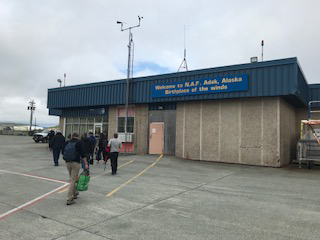
By Andrew Pietruszka, Ph.D., Underwater Archaeologist, Scripps Institution of Oceanography
July 14, 2018
Before the instruments are deployed, the data collected, and the diving begins, first you have to get there. Our expedition team is comprised of participants that hail from across the United States—from Delaware on the east coast to San Diego on the west coast—and all of us had to make our way to Kiska, Alaska—a place most of us had never heard of prior to beginning this research project.
My journey from North Carolina to Kiska began with an hour car ride from my house in Winston-Salem to the local regional airport. From there it was a three-hour flight to Dallas followed by another six hours of flying from Dallas to Anchorage. Of course, things don’t always go smoothly, and another two hours was tacked on to the journey by a thunderstorm in Dallas that forced our plane to sit on the tarmac until it passed. Arriving late and exhausted into Anchorage (it’s a five-hour difference from the Eastern Standard Time my body is used to), I quickly grabbed a bite to eat before crawling into bed at my hotel.
The next day I awoke, grabbed a reindeer sausage (you know, when in Rome) and headed to the airport to meet up with the rest of the team to catch our flight from Anchorage to Adak, Alaska, where we were to meet the boat. Adak lies nearly 1,200 miles southwest from Anchorage, approximately two-thirds of the way down the Aleutian chain. Three hours later, we touched down in Adak hoping that the sign at the airport, which reads “Welcome to N.A.F. Adak, Alaska. Birthplace of the Winds,” was not a sign of what’s to come. With its population of 326 people, according to the 2010 census, Adak, as small as it is, is literally the last bastion of civilization in this part of the world, as there are no more inhabited islands to the west.

Upon arriving at Adak, visitors are greeted by a sign reading, “Alaska Birthplace of the Winds,” an appropriate description for a location that regularly experiences winter squalls with 120 mile per hour wind gusts. Adak is roughly 430 miles from Russian waters, while Anchorage is 1,200 miles northeast. Image courtesy of the Kiska: Alaska's Underwater Battlefield expedition. Download (jpg, 63 KB).
Eager to get going, we loaded our gear into vans and trucks and made our way to the docks. After meeting the crew, a quick orientation of the boat, and mandatory safety briefs, we stowed our bags in our cabins and set sail on the R/V Norseman II, a 115-foot research vessel and our home for the next 16 days.

On our trip to Kiska, the R/V Norseman II passed many beautiful snow-capped volcanic islands in the Aleutian chain. Image courtesy of the Kiska: Alaska's Underwater Battlefield expedition. Download (jpg, 54 KB).
Despite the ominous warning that greeted us at Adak, we were blessed with calm winds and fair seas. The boat transit took us past beautiful snowcapped volcanoes and lush green islands. Along the way, we saw pods of dolphins and a few whale spouts blowing in the distance. Twenty five hours later, we arrived in Kiska late in the evening. However, given our northern latitude, we were still able to enjoy a beautiful sunset as the fog—notorious in this part of the world—slowly engulfed the harbor where we set anchor.
All total, the trip covered approximately 5,500 miles, required three modes of transportation (car, boat, and plane), and lasted three days, but before all the scientific work can be done, first you have to get there.

My 5,500-mile trip to Kiska spanned the continental United States, Canada, and Alaska. Image courtesy of the Kiska: Alaska's Underwater Battlefield expedition. Download larger version (jpg, 249 KB).